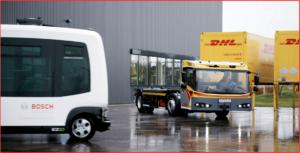A German government research program – dubbed 3F – running on test grounds in Renningen and Aachen reports that automated shuttles can move around safely, even if a technical malfunction occurs or obstacles appear suddenly. However, expensive, redundant systems are involved in keeping an autonomous vehicle running. That’s the conclusion thus far of what €4.3 million euros in grants from the German Federal Ministry of Economic Affairs bought taxpayers.
With the auto industry in full collapse given the worldwide COVID-19 pandemic and the resulting and still emerging Global Depression, it is unknown if automakers will continue to rush into developing and producing autonomous vehicles – always a dubious business proposition, which is now likely at some makers a survival issue. Invest in the unknown future, or use resources to keep the existing business alive?
The German study used Bosch as a consortium leader with three other companies, a university and a research institute: StreetScooter GmbH, RA Consulting GmbH, the FZI Research Center for Information Technology, Finepower GmbH, and RWTH Aachen University, respectively.
“Driverless shuttle buses need to meet different requirements than, say, highly automated passenger cars,” explains Bosch project coordinator Thomas Schamm. “To operate without (safety) drivers, shuttles must be able to monitor their system autonomously – in other words, perform diagnostic tasks – and cope with any technical faults detected so that they can continue driving.
“At the same time, they must be able to secure the system in the event of critical faults, for example by bringing themselves to a stop. Project 3F has been working on what the requirements look like in detail, how the systems must be designed on that basis, and how to optimize the way the individual components interact,” Schamm said.
Redundancy to duplicate safety-relevant functions is complex and expensive. Consider that the researchers developed redundant systems for the power supply so that the electrical powertrain and vehicle electrical system are reliably protected. They also adapted and refined the sensor technology to suit the vehicle design. In order to reliably detect obstacles, they installed several lidar and radar sensors at various points around the vehicle, giving it the ability to observe its surroundings from different positions. By delivering a 360-degree birds-eye view and avoiding blind spots, this creates a kind of 3D protection zone. This setup not only detects obstacles on the road, such as barriers, it also spots things like hanging branches.
Then there’s the driver, err, control computer. Another solution is to integrate fault tolerance, whereby the failure of a subsystem is at least partly compensated for by other functions. This is similar to how the people (remember them?) who are being replaced work. If the lights suddenly go out in a room, say, people use other senses and feel their way around instead of becoming paralyzed. Imagine that. A new adaptable invention – Homo Sapiens.
Therefore, a shuttle needs to behave in a similar way: if it is blind in a certain area with, say, leaves stuck to a sensor or a large object such as a dumpster or American SUV that is completely blocking the view in one direction, it slows down or omits the parts of the route that can no longer be detected. People, of course, detour all the time.
The project worked to ensure that shuttle buses can also react to altered circumstances along their defined route. The vehicles are programmed to slow down when any moving objects approach or, in case of doubt, to give unknown objects a wide berth. When they identify familiar landmarks such as streetlights, on the other hand, they resume their journey at full speed. If there is any imminent danger, the shuttle will come to a precautionary stop. The objective is for the vehicle to adapt its driving behavior to the circumstances in real time while also continuing on its journey automatically whenever possible, even in the event of system malfunctions or obstacles in its path.
Telemetry ain’t cheap. Data on the route being undertaken and the current technical status can be transmitted from the vehicle and back to it. Information on three different functions is transmitted back and forth: diagnostics, monitoring, and control. So that is three times the telemetry, which is why Bosch calls it “teletrimetry.” (Ah, give me some more or is that less German humor?) This is vital for an entire fleet of automated shuttle buses to be remotely monitored, as well as repaired or even controlled, for instance to open the doors. It means the vehicles will get help if they do ever reach their fault-detection and compensation limits, or if they simply require scheduled maintenance.
Seems to AutoInformed that UPS has a top-secret solution to these challenges: They hire and train drivers…



Pingback: Driverless Cars – People Less Positive Than You Might Assume | AutoInformed